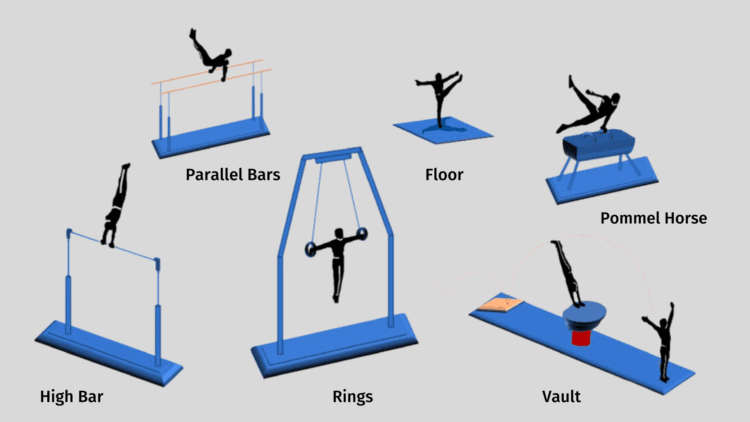
OBJECTIVE OF MEN’S GYMNASTICS: Get the best score in the six men’s gymnastics events.
NUMBER OF PLAYERS: 2+ players
MATERIALS: Floor mat, vaulting table, pommel horse, rings, parallel bars, high bar, chalk
TYPE OF GAME: Sport
AUDIENCE: 6+
OVERVIEW OF MEN’S GYMNASTICS
In men’s gymnastics, athletes perform multiple movements with a variety of different equipment. There are six men’s gymnastics events, each of which requires separate skill sets. While the gymnasts must perform in all six events, they will generally favor a particular event.
SETUP

The six events require different setups.
FLOOR
The floor event is performed on a 40×40 feet elastic mat.
POMMEL HORSE
The pommel horse is 5 feet 3 inches long and 13.5 inches wide. The handles, called the pommels, are 4.5 inches high and set around 15-17 inches from each other.
RINGS
The two rings hang 9 feet 2 inches from the floor and about 1 foot 8 inches from each other. The rings are 7 inches in diameter.
VAULT
The runway for the vault event is around 3 feet wide and 82 feet long. The vault itself sits at a height of 4 feet, 5 inches. A springboard lies before the vault to allow the gymnast to launch themselves in the air.
PARALLEL BARS
The two parallel bars are 6 feet 6 inches from the floor, sitting about 16 to 20 inches apart. The bars are 11 feet and 5 inches long.
HIGH BAR
The high bar is 9 feet 2 inches tall and is around 7 feet 9 inches long.
GAMEPLAY

Men’s gymnastics can be played as an individual or team sport, with four athletes in one team.
FLOOR
Men’s floor routines last at most 70 seconds and are not performed to a song. A routine must have each of the following:
- Forward tumbling
- Backward tumbling
- Static balance element, held for at least 2 seconds
The movements performed in the routine will require the athlete’s flexibility, flexibility, strength, and endurance. The floor routine also requires choreography and artistry.
POMMEL HORSE
A gymnast must perform at least one element of value on the front, middle, and back of the pommel horse, which is separated by the two handles or pommels. Athletes doing the pommel horse need to be able to maintain good balance when performing moves while only touching the horse with their hands. Athletes swing their legs to make circular movements around the parts of the pommel horse, showing their strength in their arms, abs, and shoulders. To dismount, the gymnast must do a handstand before landing on the side of the pommel horse with both feet firmly planted on the ground.
RINGS
The movements in the rings event best show off the gymnast’s arm and shoulder strength and their ability to maintain balance. The athlete must swing forwards and backward. And every strength element requires a hold of at least 2 seconds. Any unnecessary swings or failure to hold a strength element for 2 seconds result in deductions.
VAULT
Athletes start on the runway and run toward the springboard. The springboard creates momentum for the athlete to jump high enough to put their hands on the vaulting table, also called a horse. The athlete must then land on the other side of the horse. Of course, in gymnastics, there’s more to simply landing on the mat on the other side without falling. To get points, the gymnast must flip around and perform tricks before landing on the mat.
PARALLEL BARS
Athletes perform many swinging, balancing, holding, and flying movements, combining each of these elements accurately and fluidly. The gymnast must move up and down the bars and perform moves both above and below the bars. The routine can have up to three holds, and any additional holds or pauses are not allowed. The gymnast must also perform at least two swinging elements, one from below the bars and one from above.
HIGH BAR
Athletes will perform movements around the horizontal bar by swinging and turning. During the routine, the bar cannnot touch any part of the athlete’s body besides their hands. A high bar routine must include the following:
- Swinging forwards
- Swinging backwards
- Releasing and catching the bar
- Two different grips (the way the athlete holds the bar)
SCORING
There are two components to scoring gymnastics: difficulty (D) and execution (E). The D and E scores are then added together to determine the total score.
DIFFICULTY
Difficulty points are awarded according to the move performed by the athlete. There is a Code of Points that determines how many points each turn, jump, or other skill is worth (the Code is updated every 4 years). For example, during the vault event, a “yamashita” is worth 2 points, and a “round-off 1/2 on, layout full” is worth 5.2 points.
EXECUTION
Execution scores are out of 10, with 10 being the highest possible execution score. Athletes start with 10 points at the beginning of a routine, and deductions are given based on any mistakes from the athlete during the routine. Deductions can range from 0.1 points for leg separation to 1 point for a fall. Deductions can quickly add up, so gymnasts must do their best to perform without any mistakes.
END OF GAME
The athlete or team with the highest score in a particular event or series of events wins the competition!
- 30 GAMES TO PLAY OVER TEXT - April 22, 2024
- 20+ FREE PRINTABLE BABY SHOWER GAMES - April 16, 2024
- 20+ College Party Games for the Best Night Ever! - April 2, 2024